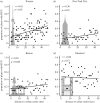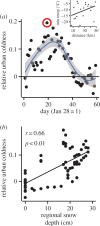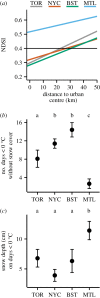Urbanization drives the evolution of parallel clines in plant populations
- PMID: 28003451
- PMCID: PMC5204167
- DOI: 10.1098/rspb.2016.2180
Urbanization drives the evolution of parallel clines in plant populations
Abstract
Urban ecosystems are an increasingly dominant feature of terrestrial landscapes. While evidence that species can adapt to urban environments is accumulating, the mechanisms through which urbanization imposes natural selection on populations are poorly understood. The identification of adaptive phenotypic changes (i.e. clines) along urbanization gradients would facilitate our understanding of the selective factors driving adaptation in cities. Here, we test for phenotypic clines in urban ecosystems by sampling the frequency of a Mendelian-inherited trait-cyanogenesis-in white clover (Trifolium repens L.) populations along urbanization gradients in four cities. Cyanogenesis protects plants from herbivores, but reduces tolerance to freezing temperatures. We found that the frequency of cyanogenic plants within populations decreased towards the urban centre in three of four cities. A field experiment indicated that spatial variation in herbivory is unlikely to explain these clines. Rather, colder minimum winter ground temperatures in urban areas compared with non-urban areas, caused by reduced snow cover in cities, may select against cyanogenesis. In the city with no cline, high snow cover might protect plants from freezing damage in the city centre. Our study suggests that populations are adapting to urbanization gradients, but regional climatic patterns may ultimately determine whether adaptation occurs.
Keywords: adaptation; cyanogenesis; herbivory; natural selection; urban evolution; white clover.
© 2016 The Author(s).
Figures




Similar articles
-
Contrasting the effects of natural selection, genetic drift and gene flow on urban evolution in white clover (Trifolium repens).Proc Biol Sci. 2018 Jul 18;285(1883):20181019. doi: 10.1098/rspb.2018.1019. Proc Biol Sci. 2018. PMID: 30051843 Free PMC article.
-
Global urban environmental change drives adaptation in white clover.Science. 2022 Mar 18;375(6586):1275-1281. doi: 10.1126/science.abk0989. Epub 2022 Mar 17. Science. 2022. PMID: 35298255
-
Predicting the strength of urban-rural clines in a Mendelian polymorphism along a latitudinal gradient.Evol Lett. 2020 Mar 25;4(3):212-225. doi: 10.1002/evl3.163. eCollection 2020 Jun. Evol Lett. 2020. PMID: 32547782 Free PMC article.
-
Evolution of life in urban environments.Science. 2017 Nov 3;358(6363):eaam8327. doi: 10.1126/science.aam8327. Science. 2017. PMID: 29097520 Review.
-
Contemporary evolution during invasion: evidence for differentiation, natural selection, and local adaptation.Mol Ecol. 2015 May;24(9):1999-2017. doi: 10.1111/mec.13162. Epub 2015 Apr 20. Mol Ecol. 2015. PMID: 25891044 Review.
Cited by
-
Online toolkits for collaborative and inclusive global research in urban evolutionary ecology.Ecol Evol. 2024 Jun 25;14(6):e11633. doi: 10.1002/ece3.11633. eCollection 2024 Jun. Ecol Evol. 2024. PMID: 38919647 Free PMC article.
-
Seasonal dynamics in the mammalian microbiome between disparate environments.Ecol Evol. 2023 Dec 18;13(12):e10692. doi: 10.1002/ece3.10692. eCollection 2023 Dec. Ecol Evol. 2023. PMID: 38111921 Free PMC article.
-
Phenotypic clines in herbivore resistance and reproductive traits in wild plants along an agricultural gradient.PLoS One. 2023 May 31;18(5):e0286050. doi: 10.1371/journal.pone.0286050. eCollection 2023. PLoS One. 2023. PMID: 37256895 Free PMC article.
-
Moving past the challenges and misconceptions in urban adaptation research.Ecol Evol. 2022 Nov 21;12(11):e9552. doi: 10.1002/ece3.9552. eCollection 2022 Nov. Ecol Evol. 2022. PMID: 36425909 Free PMC article.
-
Hybrid evolution repeats itself across environmental contexts in Texas sunflowers (Helianthus).Evolution. 2022 Jul;76(7):1512-1528. doi: 10.1111/evo.14536. Epub 2022 Jun 17. Evolution. 2022. PMID: 35665925 Free PMC article.
References
-
- United Nations Department of Economics and Social Affairs. 2014. World urbanization prospects: the 2014 revision, highlights (ST/ESA/SER.A/352).
-
- Oke TR. 1973. City size and the urban heat island. Atmos. Environ. 7, 769–779. (10.1016/0004-6981(73)90140-6) - DOI
MeSH terms
Associated data
LinkOut - more resources
Full Text Sources
Other Literature Sources

